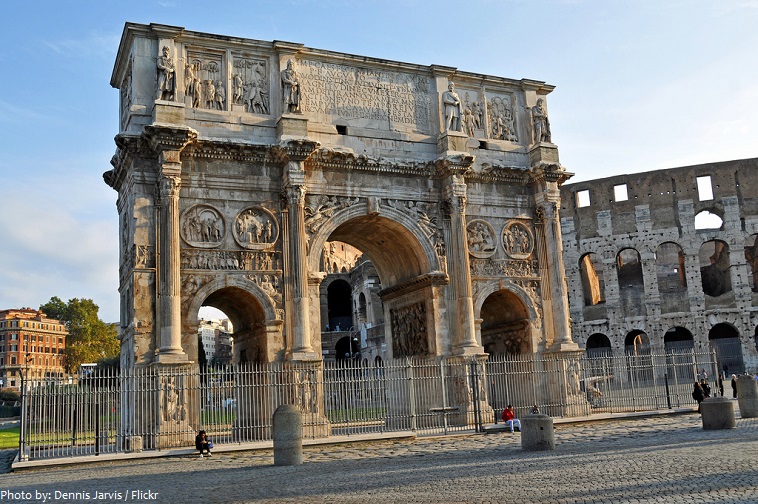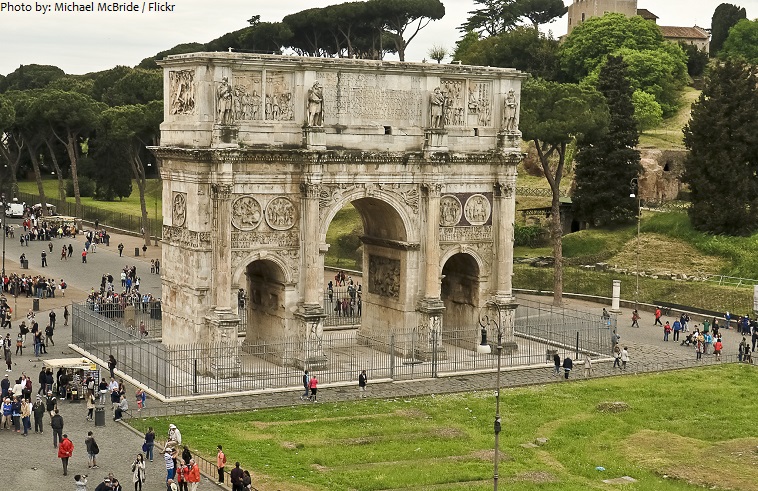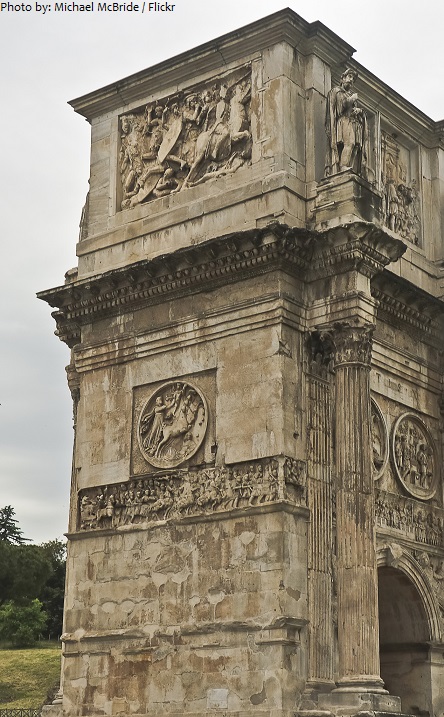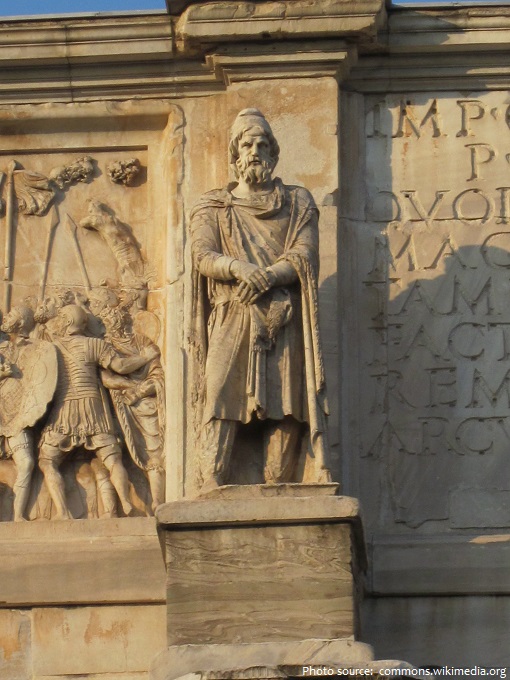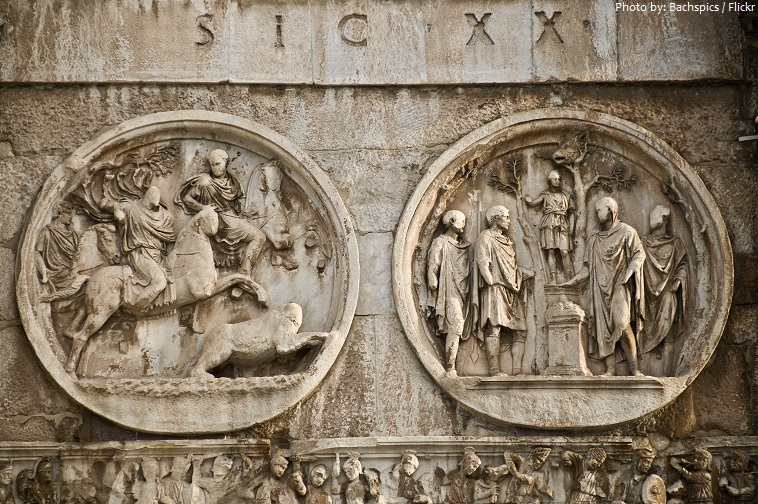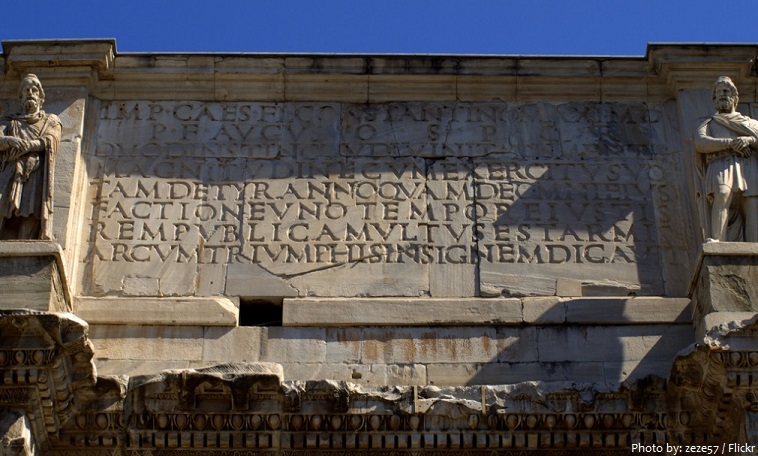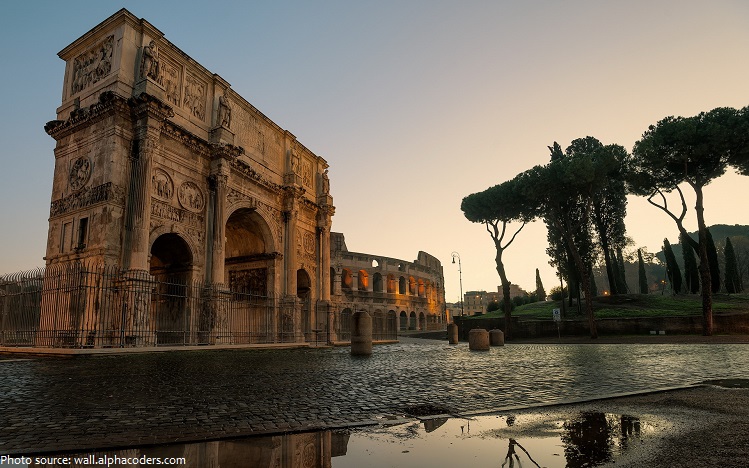The Arch of Constantine is a triumphal arch in Rome, situated right next to the Colosseum.
It was erected in 315 AD by the Roman Senate to commemorate Constantine I’s victory over Maxentius at the Battle of Milvian Bridge in 312 AD.
Faced with a much smaller army than Maxentius, Constantine carried the Christian symbol of a cross into battle and had his troops do the same. After his victory, Christianity became the accepted religion across the Roman Empire.
The arch spans the Via triumphalis, the way taken by the emperors when they entered the city in triumph.
The Arch of Constantine is the largest of the three remaining imperial triumphal arches in Rome.
The arch, decorated with statues and reliefs, has survived the times relatively unscathed.
The arch is 21 m (69 ft) high, 25.9 m (85 ft) wide and 7.4 m (24.3 ft) deep. It has three archways, the central one being 11.5 m (37.7 ft) high and 6.5 m (21.3 ft) wide and the lateral archways 7.4 m (24.3 ft) by 3.4 m (11.5 ft) each. Above the archways is placed the attic, composed of brickwork reveted (faced) with marble.
The general layout of the main facade is identical on both sides of the arch, consisting of four columns on bases, dividing the structure into a central arch and two lateral arches, the latter being surmounted by two round reliefs over a horizontal frieze.
The ends of the arch were also decorated, which was not always the case in triumphal monuments.
Many of the decorative sculptures on the Arch of Constantine have been incorporated from other monuments.
The eight sculptures at the top of the arch were from the Forum of Trajan and are a representation of Dacian warriors whom the Trajans successfully defeated in a war.
The eight rectangular reliefs in the attic come from an arch erected in AD 176 to celebrate the victories of Marcus Aurelius.
The eight medallions set in pairs above the side arches, alternately representing scenes of hunting and sacrifice, are from the time of Hadrian nearly two hundred years earlier.
The decorations on the central and lower part were created specifically for this triumphal arch. The frieze depicts episodes from the battle against Maxentius. It shows Constantine’s army driving Maxentius’ troops into the Tiber. These decorations stand out from the rest because they lack realism and are of a lower quality compared to the ones from the era of Trajan and Hadrian. This showed that the artistic level had declined during the continual civil wars over the previous century and was symbolic of the Roman Empire’s decline.
The inscription, above the central arch, is a long one and is repeated on both sides of the arch. The letters would originally have been inlaid with gilded bronze.
It reads:
IMP CAES FL CONSTANTINO MAXIMO
P F AUGUSTO SPQR
QUOD INSTINCTU DIVINITATIS MENTIS
MAGNITUDINE CUM EXERCITU SUO
TAM DE TYRANNO QUAM DE OMNI EIUS
FACTIONE UNO TEMPORE IUSTIS
REM PUBLICAM ULTUS EST ARMIS
ARCUM TRIUMPHIS INSIGNEM DICAVIT
To the emperor Flavius Constantine the Great
pious and fortunate, the Senate and People of Rome
because by divine inspiration and his own greatness of spirit
with his army
on both the tyrant and all his
faction at once in rightful
battle he avenged the State
dedicated this arch as a mark of triumph.
Though it is among the most famous monuments of its era, it also remains highly controversial due to several reasons including the belief of some historians that it was erected during the reign of Maxentius; the arch being heavily decorated with parts of older monuments; and depictions of Pagan gods and goddesses on the arch despite Constantine’s fervour for Christianity.
The monument suffered in later times, becoming a part of a fortress under the Frangipane in the Middle Ages before being restored in the 15th century CE. In c. 1597 CE Pope Clement VIII removed one of the yellow marble columns to use in a doorway of the St John Lateran church, replacing it with a purple one. However, extensive cleaning in the early 21st century CE has restored the monument to some of its former glory so that it now stands proud besides its illustrious neighbour the Colosseum of Rome.
